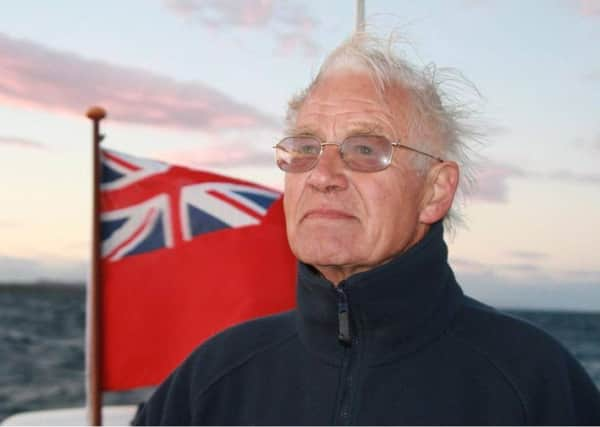Obituary: John Knox, world authority in the field of separation science


John Knox, who has died aged 90, was a world authority in the field of separation science and a pioneer in the development of modern high performance chromatographic methods, that being the process by which a chemical mixture carried by liquid or gas is separated into components.
Professor Emeritus at Edinburgh University for many years with his personal Chair in Physical Chemistry, he was appointed a Fellow of the Royal Society (Edinburgh) in 1971 and the Royal Society (London) in 1984. He played a leading role in the development of gas chromatography along with friend and colleague Howard Purnell while doing PhD research at Cambridge University under Nobel Prize Winner RGW Norrish in the early 1950s. They were the first to demonstrate its application to gas reaction kinetics which Knox considered his most important early contribution. He also made significant contributions to liquid chromatography and capillary electrochromatography, following a sabbatical in 1964 with Professor Giddings in Utah, USA, where he was introduced to column liquid chromatography. That led to his elaborating what became known as the Knox Equation, important in the theory of high performance aspects of the science.
Advertisement
Hide AdAdvertisement
Hide AdIn 1972 a Wolfson Foundation grant supported the establishment of their Liquid Chromatography Unit at Edinburgh University where Knox and his team made the notable invention of packing materials, now marketed as Hypersil and Hypercarb. They also carried out valuable research in several areas including ion-pair chromatography, and the separation of a range of drugs and their metabolites.
He wrote extensively on his expertise and travelled the world lecturing at international conferences, chairing an International Symposium in 1985 in Edinburgh. The quality of his output resulted in a number of international awards, including the Dal Nogare prize in 1983 and the Galay Medal in 2000, both for outstanding work in his field. In 2009 the Royal Society of Chemistry’s Separation Science Group honoured him by endowing the Knox Medal to be awarded to those deserving special recognition for innovative and influential contributions to separation science.
Considered a patient, inspiring teacher, generous with his time and knowledge, his unassuming nature endeared him to all with whom he had contact.
Away from professional life, he was an adventure sports enthusiast who delighted in outdoor activities such as canoeing, skiing, sailing, climbing and running. His ability as an inventor and handyman was put to good use in his leisure activities, making all sorts of items including skis and canoes while devising an alarm system called “AnchorWatch” to alert yacht crews to the danger of slipping anchor in bad weather.
John Henderson Knox was born in Edinburgh to John and Elizabeth, née Henderson, and brought up in the city’s Dalhousie Terrace with his late sister Helen. His father was a geologist with the British Geological Survey and mother a palynologist, engaged in the study of fossil pollen. Both were Fellows of the Royal Society of Edinburgh.
After attending Allermuir Primary School, Knox went on to George Watson’s College where he distinguished himself in music and science. Thereafter he completed a BSc degree at Edinburgh University in 1949 before undertaking a PhD at Pembroke College, Cambridge.
In 1957 he married Josephine Wissler in her home town, Scarborough, and the couple recently celebrated 61 years of happy marriage. They met while skiing over Swanston Golf Course in the Pentland Hills, both being members of the mountaineering club at Edinburgh University where his wife studied Social Sciences before becoming a social worker for a period. Shortly after marrying they set up home in Morningside where they remained throughout and had four sons, David, Andrew, Malcolm and Jonathan.
When younger the couple would go ski touring in the Cairngorms which then entailed walking up to the top of Cairngorm carrying the heavy home-made wooden skis before beginning their trip. Later they went skiing in the French Alps and Switzerland and he remained an enthusiastic skier till reluctantly having to stop in his mid-70s because of hip replacements. Watersports were another major passion. A member of the Forth Canoe Club, he made his own entire kit from canoes to wetsuits and daringly covered most of the challenging waterways in Scotland, falls, rivers and tidal races, including Grand Tully rapids. He was one of the first Scots to negotiate the huge rapids of the Grand Canyon and the Green River in Colorado. Wednesday afternoon runs with his students from King’s Buildings to the Pentlands was another regular activity but sailing became his major interest, initially in Albacore dinghies. He won many prizes racing and successfully crossed the dangerous Corryvreckan whirlpool. Later he enjoyed yachting round the west coast islands, first on “Mafanwy” and later on “Calema”, going as far afield as St Kilda. After a stormy night in 1988 anchored off Gometra island near Mull, fearing his anchor would drag, he developed the AnchorWatch device and after comprehensive tests designed the optimised “Knox Anchor”, now commercially manufactured. From an early age he encouraged his sons to participate in these activities and engendered lifelong interest. Although highly accomplished in outdoor pursuits, he was not immune to occasional mishaps, much to the amusement of himself and others.
Advertisement
Hide AdAdvertisement
Hide AdLatterly due to his wife’s health issues, his lifestyle changed as he dedicated himself to her continuing care and learned new skills to enable him do so. He was a much loved father whose gregarious and empathetic nature appealed to all. He is survived by his wife, children, 12 grandchildren and four great grandchildren.
JACK DAVIDSON